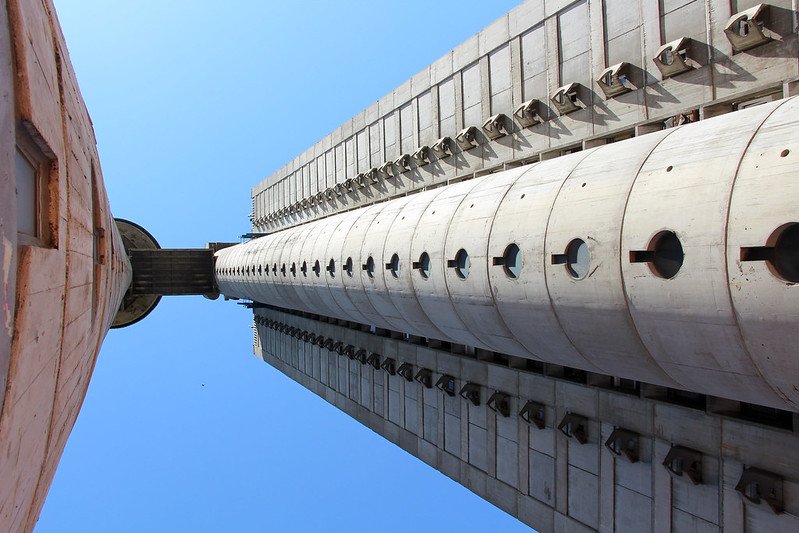Repurposing Eco-Brutalism for Modern Interiors
Have you noticed the rise of eco-brutalism in design lately? It's a trend that's hard to miss.
Combining brutalism’s emphasis on functionality and social equality with sustainable practices and a touch of greenery, eco-brutalism is redefining interior spaces. Imagine the raw, unadorned materials of brutalism paired with eco-friendly methods and abundant plant life. This blend not only creates practical and green living spaces but also makes a bold design statement.
A Brief History of Brutalism
Genex Kula, Belgrade - photo by Fred Romero
Brutalism emerged in the mid-20th century as a reaction to the ornate styles of the early 1900s and the light, airy designs of the International Style. Coined by British architectural critic Reyner Banham in the 1950s, the term "brutalism" derives from the French word for raw concrete, "béton brut."
This architectural movement was characterized by its use of exposed concrete and steel, large geometric shapes, and an emphasis on functionality over aesthetics.
In post-World War II Europe, there was a pressing need for affordable, quickly constructed housing and public buildings. Brutalism offered a practical solution, with its utilitarian approach and inexpensive materials. This style also symbolized a break from traditional architecture, representing a new era of modernity and social progress.
In Yugoslavia, brutalism found fertile ground. Innovative architects like Bogdan Bogdanović and Edvard Ravnikar embraced this style, designing structures that were not only functional but also carried cultural and historical significance. The Genex Tower in Belgrade, for example, stands as one of the most iconic brutalist buildings, with its striking dual towers connected by a bridge at the top. The Petrova Gora Monument is another remarkable example, commemorating the resistance fighters of World War II with its imposing, futuristic design.
Brutalism's influence was not confined to Europe. In Seoul, South Korea, the Sewoon Sangga Complex, designed by Kim Swoo-geun in the 1960s, is a notable example of brutalist architecture.
This mixed-use development integrated residential, commercial, and industrial spaces, demonstrating the versatility of brutalist principles. Other influential brutalist structures around the world include the Barbican Estate in London, known for its striking residential towers and cultural facilities, and Habitat 67 in Montreal, an innovative housing complex designed by Moshe Safdie that reimagined urban living.
How to Achieve Eco-Brutalism Indoors
Bringing eco-brutalism into your home involves combining the raw, minimalist elements of brutalism with sustainable practices and natural greenery. Here are some tips to help you achieve this look:
Bosco Vericale, Milano, Italy
Use Sustainable Materials
Recycled Concrete and Steel: Opt for furniture and fixtures made from recycled concrete and steel. These materials are not only eco-friendly but also capture the raw aesthetic of brutalism.
Reclaimed Wood: Incorporate reclaimed wood for a touch of warmth and sustainability. Use it for flooring, wall panels, or furniture to balance the hard textures of concrete and steel.
Natural Stone: Integrate natural stone elements such as countertops or accent walls. Locally sourced stone is ideal for reducing environmental impact.
Embrace Minimalism
Clean Lines and Simple Shapes: Choose furniture and decor with clean lines and simple, geometric shapes. This creates a sense of order and functionality.
Neutral Color Palette: Stick to a neutral color palette with shades of gray, black, white, and earth tones. This enhances the minimalist feel and highlights the natural materials.
Incorporate Greenery
Indoor Plants: Add large indoor plants like fiddle leaf figs, snake plants, or monstera to bring life and freshness to your space. Place them strategically to create focal points.
Vertical Gardens: Install vertical gardens on walls to maximize greenery without taking up floor space. This can be a striking feature that softens the rawness of brutalist materials.
Natural Light: Maximize natural light by using large windows and skylights. This not only illuminates the space but also supports plant growth.
Focus on Functional Design
Multi-Purpose Furniture: Choose furniture that serves multiple purposes, such as storage benches or modular shelving units. This enhances functionality and maintains a clutter-free environment.
Open Floor Plans: Embrace open floor plans to create a sense of spaciousness and flow. This aligns with brutalism's emphasis on practicality and social interaction.
Integrate Eco-Friendly Systems
Energy Efficiency: Install energy-efficient lighting, heating, and cooling systems. LED lights, smart thermostats, and solar panels can significantly reduce energy consumption.
Water Conservation: Use water-saving fixtures like low-flow faucets and toilets. Consider incorporating rainwater harvesting systems for sustainable water use.
By following these tips, you can create an eco-brutalist interior that is both stylish and sustainable, blending the raw beauty of brutalism with the nurturing presence of nature.
The Repurposing of Brutalism's Functional Efficiency in Interior Design
Brutalism, with its emphasis on functional efficiency through standardized construction methods and modular components, offers valuable insights for contemporary interior design. Here’s how these principles can be repurposed to create impactful interior spaces:
1. Functional Efficiency in Space Utilization
In interior design, embracing modular elements akin to brutalism allows for efficient space utilization. Modular furniture systems, such as sectional sofas or modular shelving units, can be customized and rearranged to adapt to different spatial configurations and functional needs. This versatility maximizes usable space within homes and commercial interiors, catering to diverse lifestyles and activities.
2. Streamlined Aesthetic and Structural Integrity
Just as brutalist architecture prioritizes a streamlined aesthetic and structural integrity, interior spaces can benefit from clean lines, geometric shapes, and minimalist design principles. Incorporating raw materials like exposed concrete, steel, and natural wood accents not only enhances visual appeal but also reinforces the durability and timeless elegance associated with brutalism.
3. Cost-Effective and Sustainable Materials
Repurposing brutalism’s emphasis on cost-effective and sustainable materials in interior design supports environmentally conscious practices. Opting for recycled or locally sourced materials—such as concrete countertops, reclaimed wood flooring, or modular wall panels—reduces environmental impact while adding texture and character to interior spaces. These materials also contribute to a cohesive, eco-friendly aesthetic that resonates with modern sensibilities.










Energy efficiency is a smart strategy that benefits both businesses and society as a whole.